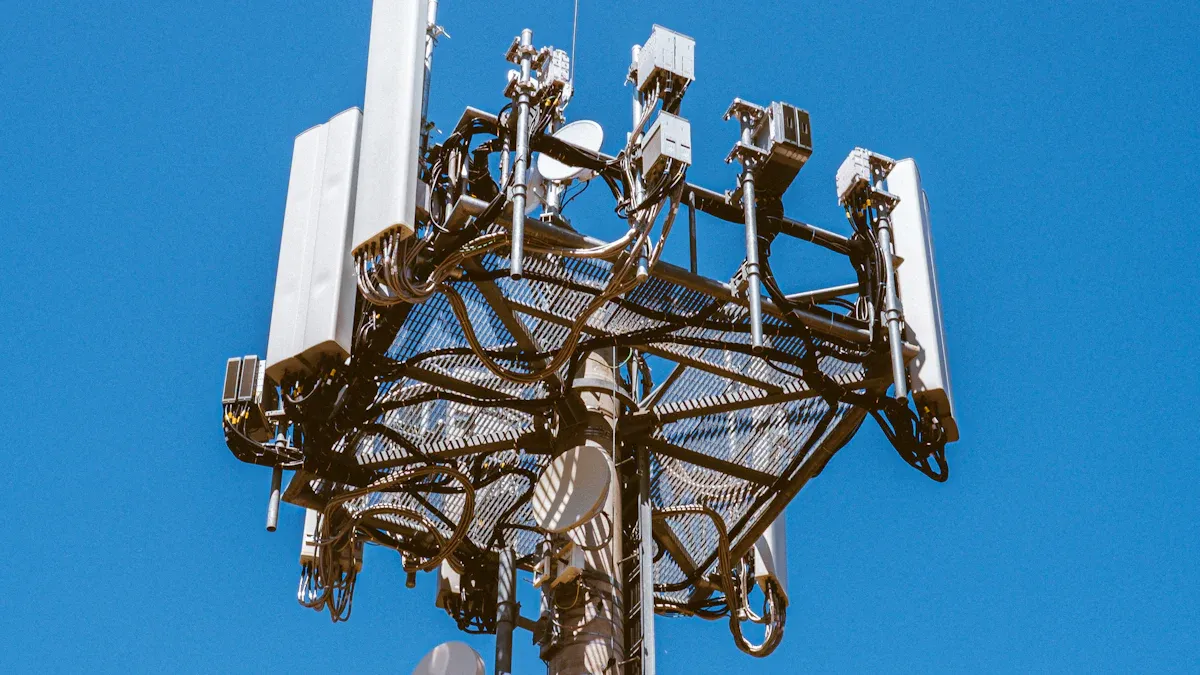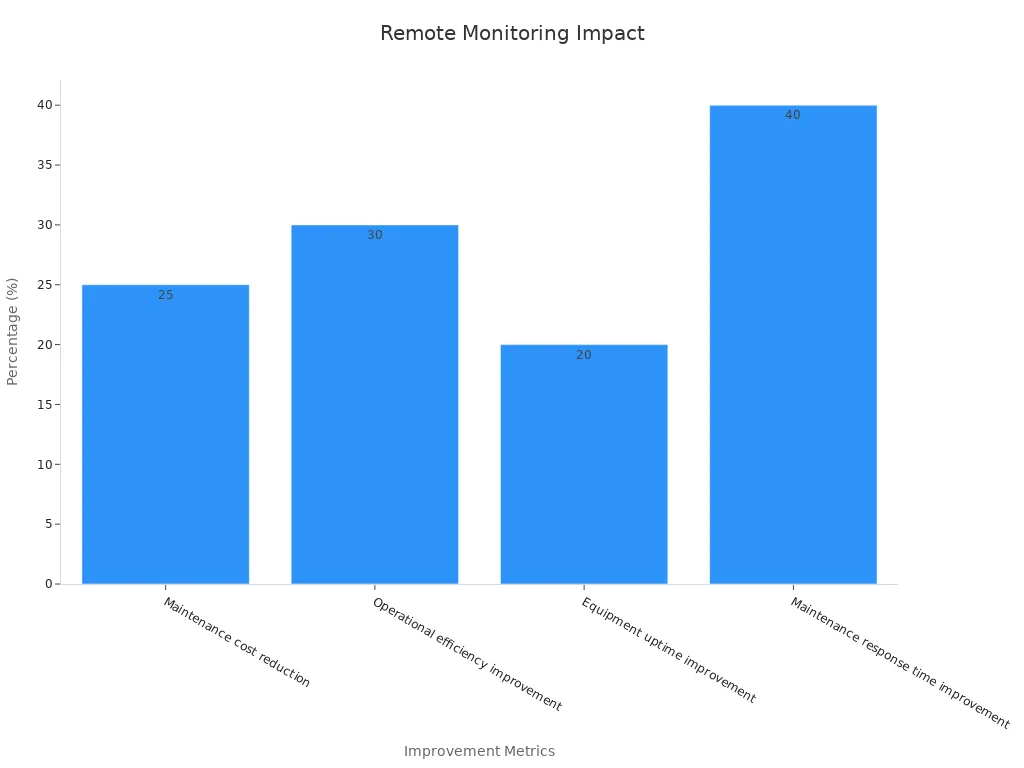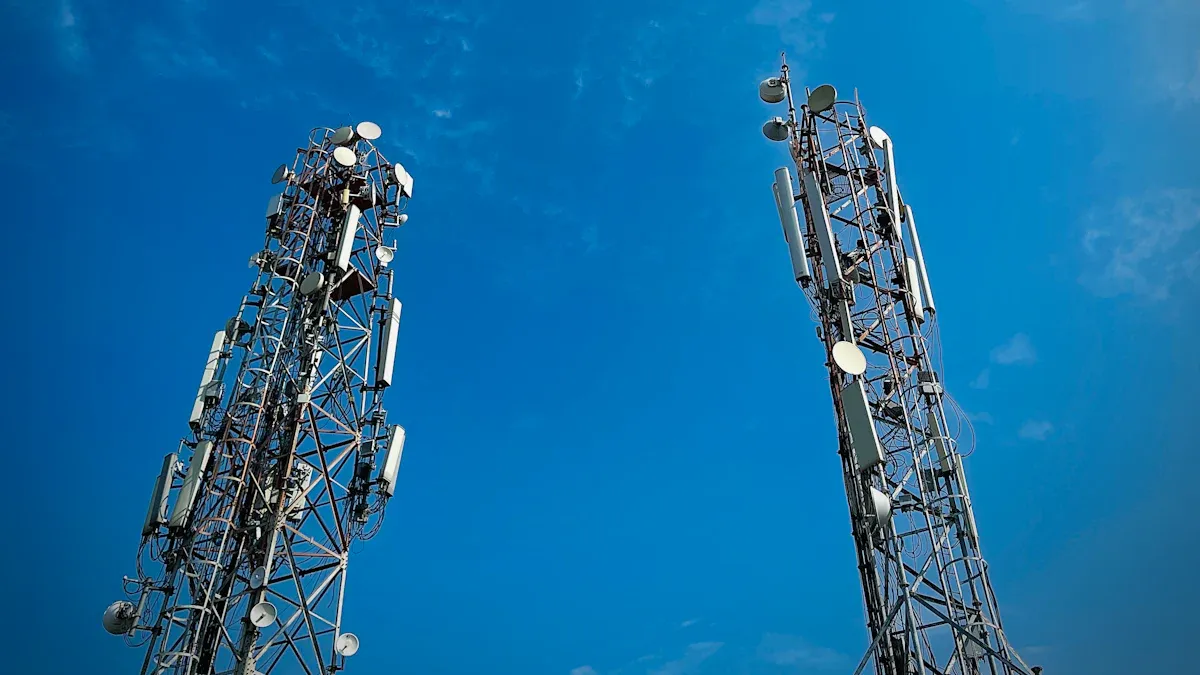Why Modern Power Supply Rectifiers Reduce Costs in Telecom Networks

Modern power supply rectifiers drive cost savings across telecom networks by delivering superior efficiency, reliability, and adaptability. Telecom rectifiers play a pivotal role in powering communication networks, holding nearly half the market share and ensuring stable DC output for critical telecom infrastructure. High-efficiency rectifier designs now reach up to 98%, cutting power loss by as much as 75% compared to older models. Networks benefit from reduced operational costs, lower maintenance, and seamless integration with hybrid and renewable systems. Key components of telecom rectifiers, such as advanced automation and AI-driven monitoring, further decrease downtime and expenses. Choosing the right telecom rectifier system has become essential for telecom operators aiming to optimize network performance and long-term cost control.
Key Takeaways
Modern telecom rectifiers deliver high energy efficiency up to 98%, cutting power loss and lowering electricity costs significantly.
Advanced rectifiers provide stable and reliable DC power with backup and modular designs, reducing downtime and protecting telecom equipment.
Modular systems and remote monitoring simplify maintenance, reduce site visits, and lower operational expenses for telecom operators.
Scalable rectifier designs allow easy network expansion and seamless integration with existing infrastructure, supporting fast 5G growth.
Efficient rectifiers support renewable energy sources, helping telecom networks reduce carbon emissions and achieve sustainability goals.
Energy Efficiency in Telecom Rectifiers

High Efficiency
Telecom networks demand reliable, cost-effective power delivery. Modern telecom rectifier systems achieve high efficiency, often reaching 97% or more in AC to DC conversion. This level of efficiency means less energy waste and lower electricity bills for telecom operators. The latest power supply rectifier designs use advanced technologies such as Superjunction MOSFETs and GaN semiconductors, which push efficiency targets to nearly 98%. These improvements directly reduce operational costs and support energy optimization across telecom sites.
High efficiency in telecom rectifiers also leads to less heat generation. Lower heat output reduces the need for cooling systems, which further cuts energy consumption and maintenance expenses. Operators see measurable savings as a result.
The following table highlights key efficiency metrics in modern telecom rectifier systems:
Metric/Feature | Value/Description |
|---|---|
Current Efficiency | Up to 97% efficiency in AC to DC conversion |
Future Efficiency Target | Approximately 98% efficiency |
Total Rectifier Modules Deployed | Around 2,400,000 modules with near 97% efficiency |
Technological Advancements | Superjunction MOSFETs, GaN technology |
Efficient rectifiers also contribute to sustainability. For example, the GreenConnect project reported a 30% reduction in energy use and a 40% drop in CO2 emissions after deploying high efficiency telecom rectifiers at 500 remote sites. These results show why telecom operators increasingly invest in efficient rectifiers to meet both financial and environmental goals.
Power Factor Correction
Active power factor correction (PFC) plays a critical role in telecom rectifier systems. Without PFC, rectifiers may operate with a power factor as low as 0.5, leading to significant energy loss and higher utility costs. Modern telecom rectifiers use active PFC to achieve power factors between 0.95 and 0.99. This improvement ensures that more of the supplied power is used effectively, minimizing losses and reducing heat.
PFC Type | Typical Power Factor Range |
|---|---|
No PFC | 0.5 – 0.65 |
Passive PFC | 0.6 – 0.8 |
Active PFC | 0.95 – 0.99 |
Telecom operators benefit from active PFC because it supports energy optimization and helps maintain stable power delivery. Efficient rectifiers with advanced PFC reduce the strain on electrical infrastructure and lower the risk of costly downtime. These factors explain why telecom networks rely on modern rectifier systems to achieve both operational savings and long-term sustainability.
Reliability and Stable Power Supply
Consistent DC Output
Telecom networks depend on steady DC power to maintain high reliability and protect sensitive equipment. Telecom rectifiers convert AC power into a stable DC voltage, which is essential for the continuous operation of telecom infrastructure. The rectifier module uses built-in voltage regulation to keep the DC output constant, even when the AC input fluctuates. This steady DC power prevents voltage spikes and drops that could damage critical telecom equipment or disrupt service.
Telecom rectifiers often feature advanced monitoring and modular designs. These systems allow early detection of issues, enabling repairs without shutting down the entire network. Operators can replace or repair a single rectifier module while the rest continue to deliver steady DC power. This approach ensures better network reliability and supports high system uptime.
Research on advanced rectifier systems, such as three-level PWM rectifiers with dual closed-loop control, demonstrates high performance. These systems achieve a power factor of 0.99, low total harmonic distortion, and efficiency rates above 95%. Such performance metrics confirm that telecom rectifiers deliver the consistent DC output required for uninterruptible power supply and optimal telecom performance.
Reduced Downtime
Minimizing downtime is a top priority for telecom operators. Modern telecom rectifiers use redundancy, backup functionality, and smooth power switching to prevent costly service interruptions. If one rectifier fails, others immediately take over, maintaining steady DC power and uninterrupted telecom service.
Operators benefit from advanced remote monitoring, which allows them to detect and resolve issues before they escalate. This proactive approach reduces downtime and protects network performance.
Feature | Benefit for Reliability and Uptime |
|---|---|
Redundancy | Prevents outages by allowing other rectifiers to take over |
Battery Backup | Ensures steady DC power during AC failures |
Modular Design | Lowers risk of complete power failure |
Telecom rectifiers with backup systems provide additional stability. Backup batteries supply steady DC power during outages, ensuring telecom equipment continues to operate. Data shows that DC power systems using telecom rectifiers are over 20 times more reliable than traditional UPS systems. Approximately 70% of new 5G installations rely on advanced rectifiers to maintain continuous operation and system uptime.
Modern telecom rectifiers, with their focus on reliability, steady DC power, and backup, play a crucial role in reducing downtime and supporting the high performance required in today’s telecom networks.
Maintenance and Operational Savings
Modular Design
Telecom operators choose modular design in telecom rectifiers to simplify maintenance and reduce costs. Modular rectifier systems allow technicians to replace or upgrade individual rectifier modules without shutting down the entire system. This approach minimizes service interruptions and keeps telecom networks running smoothly. Quick installation, often completed in a single day by certified installers, further reduces downtime and labor expenses.
Operators see significant savings because modular telecom rectifiers lower the need for on-site visits. Remote digital site surveys and thorough planning prevent unnecessary trips. Batteries in these systems often come with a 10-year warranty and show no visible capacity fade, unlike traditional lead-acid batteries that require frequent replacement. The compact size and high power density of modern rectifiers enable centralized racks, which reduce cabling and cooling costs across telecom sites.
Modular telecom rectifiers cut maintenance costs to about 7% of what traditional diesel generator and lead-acid systems require.
Aspect | Evidence / Quantification |
|---|---|
Maintenance Cost Reduction | Maintenance costs reduced to approximately 7% of traditional diesel generator and lead-acid systems. |
Reduced Site Visits | Remote monitoring via cloud software decreases the need for physical site visits. |
Installation Time | Modular design enables quick installation, typically completed in one day by local certified installers. |
Battery Replacement Frequency | Batteries have a 10-year warranty with no visible capacity fade, compared to typical 2-year lifespan lead-acid. |
Planning & Site Survey | Remote digital site surveys and thorough planning minimize on-site time and prevent additional visits. |
Operational Reliability | Continuous remote monitoring with real-time alerts reduces need for on-site troubleshooting visits. |
Remote Monitoring
Remote monitoring transforms telecom maintenance by enabling real-time monitoring and advanced monitoring of rectifiers and systems. Operators track performance, receive alerts, and diagnose issues from any location. This capability leads to faster response times and fewer emergency repairs. AI-driven predictive maintenance detects failures weeks in advance, reducing unexpected disruptions and improving operational reliability.
The impact of remote monitoring on telecom rectifiers is clear:
Metric / Impact | Reported Improvement |
|---|---|
Maintenance cost reduction | Up to 25% savings |
Operational efficiency improvement | 30% increase |
Equipment uptime improvement | 20% increase |
Maintenance response time improvement | 40% faster response |
Mean Time to Repair (MTTR) reduction | From 4.8 hours to 3.1 hours |
Reduction in emergency repairs and site visits | Significant decrease |
AI-driven predictive maintenance | Early failure detection |

Telecom rectifiers with remote monitoring and real-time monitoring capabilities help operators achieve up to 25% maintenance cost savings. They also improve operational efficiency by 30% and increase equipment uptime by 20%. These systems support fewer site visits, faster repairs, and better planning. Telecom networks benefit from lower total cost of ownership and improved reliability when they deploy rectifiers with advanced monitoring features.
Scalability and Flexibility in Telecom Networks
Easy Expansion
Telecom operators face constant pressure to expand networks quickly and efficiently. Modern telecom rectifiers play a vital role in enabling this growth. Telecom rectifier systems use modular designs that allow operators to add or replace rectifiers as demand increases. This approach reduces the need for large upfront investments and prevents overbuilding. Operators can scale systems in small increments, matching capacity to actual network requirements.
Real-world deployments show why telecom rectifiers simplify expansion. For example, Asentria’s SiteBoss automation system manages power, security, and environmental controls at telecom sites. By automating rectifier and battery monitoring, SiteBoss reduces maintenance challenges and supports stable power at remote locations. This stability makes it easier for operators to expand networks into new areas without risking service interruptions.
Vertiv’s NetSure IPE outdoor rectifier demonstrates how telecom rectifier systems support rapid network growth. Its compact design and lithium-ion battery backup enable fast deployment in outdoor and high-demand environments, such as stadiums and airports. Operators can roll out new 5G sites with minimal delay, ensuring reliable power even in harsh conditions.
Operators choose telecom rectifiers with advanced switch-mode power supplies and active power factor correction to reduce energy losses and heat. These features lower operational costs and make network scaling more efficient.
Infrastructure Integration
Telecom rectifiers must integrate seamlessly with existing infrastructure to support evolving network needs. Modern systems use advanced materials like SiC and GaN, which increase efficiency and reduce size. This compactness allows rectifiers to fit into existing racks and cabinets, minimizing the need for costly upgrades.
The following table highlights how investments and technology advancements drive scalable telecom applications:
Area | Impact on Scalability and Flexibility |
|---|---|
Data Center Growth | Drives demand for efficient rectifiers in IT and cloud infrastructure |
5G Network Expansion | Requires reliable, compact rectifiers for new telecom sites |
Smart Grid Deployment | Increases need for advanced rectifier systems in telecom networks |
Semiconductor Advances | Enables smaller, more efficient rectifiers for diverse applications |
Telecom rectifier systems support both legacy and next-generation networks. Operators can deploy rectifiers in existing telecom towers, data centers, and smart grid environments. This compatibility ensures that telecom networks remain flexible and ready for future technologies.
Renewable Energy Integration

Lower Long-Term Costs
Telecom operators choose modern rectifiers to support renewable energy sources because these systems deliver lower energy and running costs over time. Rectifiers with high efficiency convert solar and wind power into usable DC energy for telecom infrastructure. This process reduces reliance on fossil fuels and cuts electricity bills. Operators see less energy loss, which means cooling systems work less and maintenance costs drop. Modular rectifier systems allow telecom companies to scale power deployment as needed, avoiding overspending on unnecessary capacity.
Modern DC rectifiers reach up to 97% efficiency, which reduces energy waste and lowers carbon emissions.
These rectifiers integrate seamlessly with solar and wind, enabling a cleaner power supply for telecom sites.
Lower energy loss leads to reduced cooling costs, which contributes to overall savings.
Market data shows DC rectifier adoption will grow, with revenue expected to rise from $4.2 billion in 2019 to $5.5 billion by 2025, reflecting their economic value.
A study on hybrid renewable energy systems for telecom shows that certain configurations can cut cumulative cash flow by nearly 75%. This demonstrates why telecom networks benefit financially from integrating rectifiers with renewable sources.
Sustainability
Telecom networks face increasing pressure to meet green goals and reduce environmental impact. Modern rectifiers help operators achieve these objectives by supporting renewable energy integration. These systems efficiently convert solar and wind energy, which lowers carbon emissions and supports sustainability targets.
Telecom rectifiers enable operators to future-proof their networks for green initiatives and regulatory requirements.
The following table highlights the environmental benefits of different telecom power configurations:
Configuration Type | CO2 Emissions (kg/year) | Renewable Fraction (%) | Energy Efficiency | Notes on Costs and Operation |
|---|---|---|---|---|
Grid-only | 2593 - 2599 | < 0.3 | Stable electricity | Baseline emissions, zero unmet loads |
Grid + PV + Batteries | 2441 | 6.1 | Improved | Reduced emissions, higher operational costs |
Off-grid PV + Batteries | 0 | 100 | Significantly improved | Zero emissions, higher net present cost |
Telecom operators use rectifiers to support renewable energy, which leads to measurable reductions in CO2 emissions. For example, one configuration emits only 531.7 tons of CO2 over its life cycle, with a carbon emission rate of 17.9 gCO2/kWh. These results show why telecom networks rely on rectifiers to meet sustainability goals and prepare for future environmental standards.
Modern telecom networks realize significant cost savings by deploying advanced rectifiers. Operators benefit from high energy efficiency, reduced maintenance, proven reliability, and seamless integration with renewable energy. The following table highlights why these systems lower total cost of ownership:
Aspect | Cost-Saving Benefit / Impact |
|---|---|
Energy Efficiency | Reduces electricity costs and carbon emissions |
Maintenance & Support | Lowers repair costs and extends equipment life |
Scalability | Enables incremental upgrades, saving capital expenditure |
Backup Integration | Prevents service interruptions, reducing revenue loss |
Deployment Scale | Proven technology reduces risk and ownership costs |
Telecom decision-makers should consider upgrading rectifiers to modern systems for long-term financial and operational advantages. Key industry trends show why these systems will continue to evolve:
The telecom power system market is projected to grow rapidly.
Modular architectures and embedded analytics enhance reliability and operational efficiency.
Integration with renewable energy and hybrid power drives innovation in rectifiers.
Telecom networks that invest in advanced rectifiers position themselves for future growth, improved reliability, and sustainable operations.
FAQ
Why do telecom operators prefer modular rectifier systems?
Operators choose modular rectifier systems because these systems allow quick upgrades and repairs. Modular designs reduce downtime and lower maintenance costs. Operators can scale power capacity as network demands grow, which helps control capital expenses.
Why does remote monitoring matter for telecom rectifiers?
Remote monitoring enables operators to track system performance in real time. This approach helps detect issues early and reduces emergency site visits. Operators save money and improve network reliability by using advanced monitoring tools.
Why do modern rectifiers support renewable energy integration?
Modern rectifiers support renewable energy because they convert solar and wind power efficiently. This integration lowers long-term energy costs and helps operators meet sustainability goals. Operators also reduce their carbon footprint by using renewable sources.
Why is high efficiency important in telecom rectifiers?
High efficiency in telecom rectifiers reduces energy waste and lowers electricity bills. Operators benefit from less heat generation, which decreases cooling needs. Efficient rectifiers also support sustainability targets by minimizing environmental impact.
Why do telecom networks require advanced monitoring features?
Advanced monitoring features provide real-time alerts and predictive maintenance. Operators use these tools to prevent failures and optimize performance. Monitoring systems help maintain uptime and reduce operational costs across telecom networks.
See Also
Reasons Lithium Batteries Excel Over Other Options In Telecom
Understanding -48VDC Use And Positive Terminal Grounding In Telecom
Methods For Calculating Power Systems And Batteries In Telecom
Major Distinctions Between Communication And Standard Power Supplies
CALL US DIRECTLY
86-13752765943
3A-8, SHUIWAN 1979 SQUARE (PHASE II), NO.111, TAIZI ROAD,SHUIWAN COMMUNITY, ZHAOSHANG STREET, NANSHAN DISTRICT, SHENZHEN, GUANGDONG, CHINA

